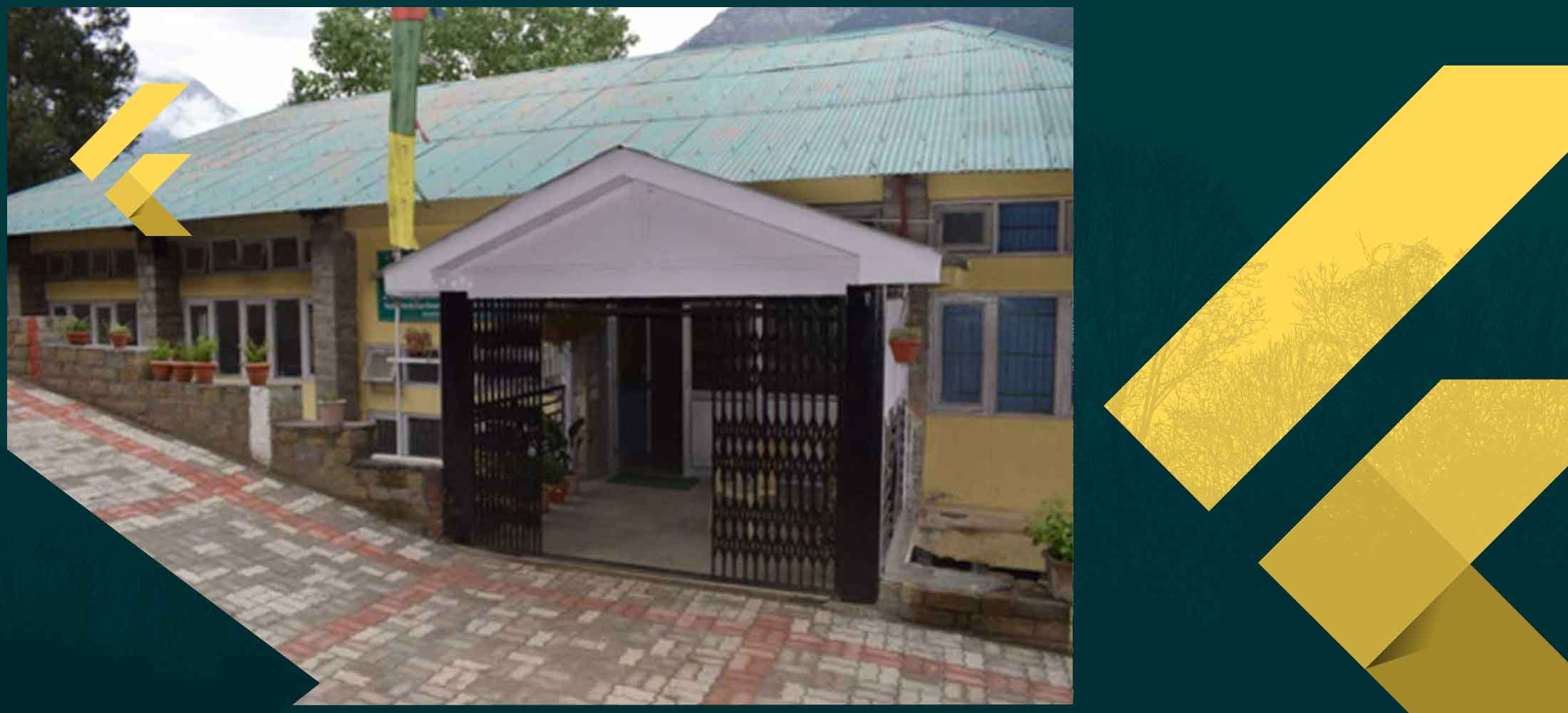
During 2015-16 about 200 soil samples were collected from various locations of NICRA village Telangi. The location of the samples was tagged by Global Positioning System (GPS). Approximately 155 samples were analyzed last year and the remaining samples were analyzed this year for pH, CEC, Organic Carbon, N, P and K in the soil laboratory of KVK, Kinnaur. From the analysis it is observed that the soil of this village is near neutral and generally low in nitrogen. The soil organic carbon is in medium range, very high phosphorus content and medium to high potash contents. 46 number of soil health cards have been distributed to the farmers of village Telangi by identifying them through GPS system. This year atomic absorption spectrophotometer (AAS) has been purchased for the soil lab in order to analyze micronutrient status in soils and plants. One soil testing kit has also been procured this year which enabled us to analyze some of the soil micronutrients along with soil pH, CEC, Organic Carbon, P and K. Till date, 17 number of soil samples brought by farmers of different villages has been analyzed with the help of this soil testing kit.
The feeding by woolly apple aphid in or near the leaf axils destroys the buds and results in heavy crop losses both quantitatively and qualitatively. It has also been observed that the trees which are growing vigorously with plenty of new shoots, there is rapid increase in aphid population. During summers winged females are also dispersed and cause initiation of new colonies on un-infested plants. In apple plantation of Kinnaur district of Himachal Pradesh both type of aphid movements has been observed. The root to aerial part movement peaks during summer season (May-June) where as there is rapid decline in aerial population during the winters (Oct- November) due to the downward movement of this insect. The crawlers move downward through the trunk to root zone and overwinters. It has also been reported to overwinter as nymph on the above ground parts of the tree under the protected areas on the trunk or under the crotchet angle of apple shoots, but the aerial population is generally killed by the severe winter of this region.
The movement of woolly apple aphid from roots to the shoots during the spring season is the major reason for the start of aerial infestation in apple plants. Although some of the root stocks of (Malling-Merton) like MM-111, M6 MM-106 has been reported to be resistant to some extent against woolly apple aphid but in Kinnaur district maximum apple plantation is on seedling rootstock and the management of WAA is only done through the chemicals for both the aerial populations as well as for the subterranean population. These methods of woolly apple aphid management are not eco-friendly and may lead to number of health related problems and resistance to insecticides used. The non-judicious use of these chemicals have also resulted in the decline of its natural enemies like Ladybird beetle, Lacewing fly, Syrphids and Aphilinus mali (last one being parasitoid).
The sticky bands have been used by most of the researchers only to monitor the movements of WAA. In this method the use of physical barriers i.e. sticky bands are advocated on the trunks of the plants having the aerial population. The method is found to kill woolly aphid by mass trapping if these are installed on the trunks of apple tree on the start of winters. The installation of sticky bands during this particular time prevents the downward moving population of WAA from entering the root zone, thus killing the insect either by the lack of feeding site or by the adverse conditions during the winter where the temperature reached to the negatives of degree Celsius. Keeping in view the above ideas in mind the studies were conducted in apple orchards of RHR&TS and KVK Kinnaur (site1) as well as in two private orchards, viz. community orchard at Buddhist monastery, Reckong Peo and other at farmer’s field in the NICRA village Telangi (site2) where sufficient population of woolly apple aphid was observed. The sticky monitoring bands of 10 cm width were installed 1 ft above the ground on infested apple tree trunk. Every fortnight the bands were replaced to make woolly apple aphid movement count as well the movement direction. Over the two working seasons from March to December for two consecutive years the population of insect was monitored. The aphid movement was noticed throughout the year in the above mentioned period and there were two major movements. First major movement was an upward during June and July where average 62.40 (site 1) and 88.72 (site 2) numbers of first instar nymphs were found to be trapped in per square cm area of band in 2015 (site 1) and 2016 (site2) respectively. The second major movement was downward during the months of October where 330.9 and 264.18 number of first instar nymphs of WAA were found to be trapped during the year of 2015 and 2016 respectively (Fig 1.). On site 1 where the application of sticky bands was done resulted in reduction of colony development for the year of 2016. During the year 2016 the maximum number of colonies per 10 cm length of the shoot was found reduced as compared to the control (Fig.2). Whereas few of the aphids which were present on the plants under band application having maximum colony size of 6.8 mm2 as compared to 59.2 mm2 in control (Fig 3) indicating huge reduction in the aphid population.
The method is absolutely free from the use of any kind of insecticides thus promises the woolly apple aphid management in an eco-friendly way with little cost.
Horticultural performance of Pistachio nut revealed that there was problem of blank nut due to non synchronization of flowering in male and female cultivars. Total fruit yield of the crop was recorded almost negligible.
Almond cultivars viz. Non-Pariel, Merceed, Pranyz, Primorskij, Waris, IXL and Makhdoom are under evaluation in dry temperate conditions. During the year 2016, Non- Pariel and Waris cultivars attained the maximum plant height (370 cm), plant diameter (8.9 mm) and annual shoot extenstion growth (148 cm).
Hundred plants of two imported cultivars of pears namely Concord (50) and Carmen (50) on B/A 29 rootstock were also planted at the research station and are also under evaluation in dry temperate condition.
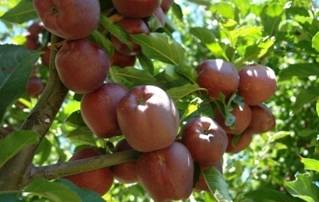
Oregon Spur 1
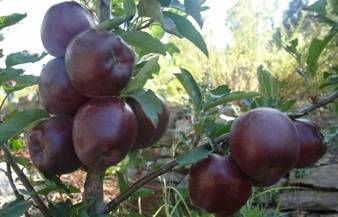
Super Chief
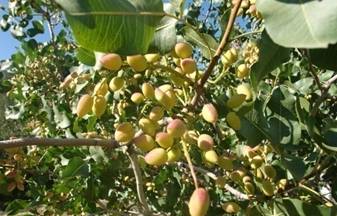
Kermany
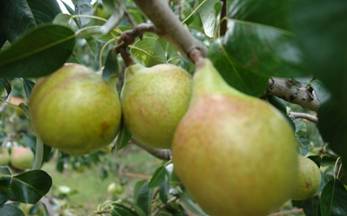
Red Bartlett
The increasing market demand for Kinnaur apples has resulted in an increase in demand for planting material because the tribal people has now become fully aware of benefits of apple cultivation and are interested in covering more and more land under apple where ever they can. This trend is still continuing and every year due to change in climate, the higher reaches “Kande” are being brought under apple cultivation. With limited resources at Regional Horticultural Research & Training Station and KVK, Sharbo, 11,250 healthy grafted fruit plants were produced.
The nursery plants of different cultivars of apple, apricot and grapes were inspected before sale. A total of 15,406 plants were inspected out of which, 11,250 no of plants were found healthy for sale whereas, 4,156 number of plants were rejected, based on damage during uprooting, poor and under developed root system, improper graft union and height and problem of insect pests and soil borne diseases. However, less number of saleable plants from KVK nursery are due to the damage caused to the nursery due to flood during last three years and further after transplanting these plants did not grow well and hence more number of unhealthy and diseased plants were destroyed during the inspection by the committee.
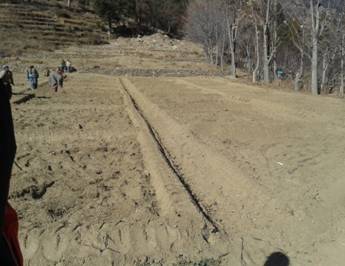
Bed preparation and Seed Sowing
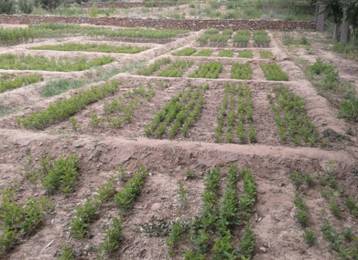
Raising of Raising
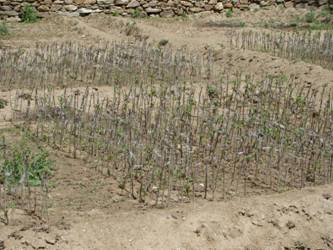
Grafted Apple plant

Grafted Apple plant
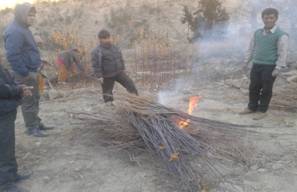
Nursery inspection
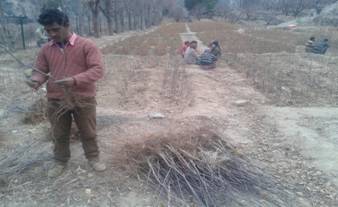
Nursery inspection
| Crop (Variety) | Total number of plants | Number of plants rejected | Number of saleable plants |
| Apple | |||
| Royal delicious. | 7775 | 1910 | 5865 |
| Golden delicious | 299 | 75 | 224 |
| Red Golden | 41 | 15 | 26 |
| Oregon sp-I | 1014 | 381 | 633 |
| Oregon sp-II | 101 | 40 | 61 |
| Super chief | 1197 | 408 | 789 |
| Golden spur | 244 | 80 | 164 |
| Red chief | 332 | 110 | 222 |
| Gale gala | 433 | 160 | 273 |
| Early red one | 99 | 35 | 64 |
| Scarlet spur | 365 | 130 | 235 |
| Apricot | |||
| Shakarpara | 50 | 20 | 30 |
| Yerwani | 15 | 10 | 5 |
| Steni | 15 | 10 | 5 |
| Safeda | 115 | 50 | 65 |
| Grapes | |||
| Thompson seedless | 457 | 200 | 257 |
| Black Prince | 70 | 26 | 44 |
| Kandhari | 91 | 60 | 31 |
| Almond | |||
| Non pariel | 56 | 20 | 36 |
| Pear | |||
| Star Krimson | 48 | 16 | 32 |
| Plants sold from KVK nursery | |||
| Apple | |||
| Royal Del. | 2580 | 400 | 2180 |
| TSL | 9 | 0 | 9 |
| Total | 15406 | 4156 | 11250 |
| Technology tested | Number of trials | Size of colony per 10 cm of shoot |
Per cent Wooly aphid reduction over farmer practice |
| Farmer Practice | 2 | 8.2 | - |
| Use of sticky bands | 1.0 | 76 % |
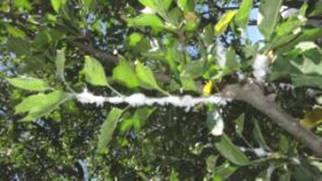
Woolly apple infestation in apple plant
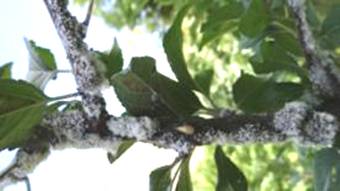
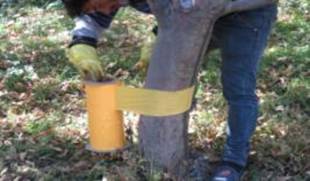
Installation of sticky bands on apple tree
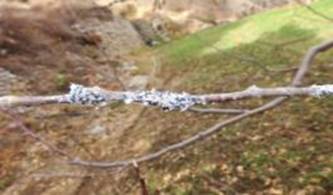
Aphilinus mali infested colonies of WAA
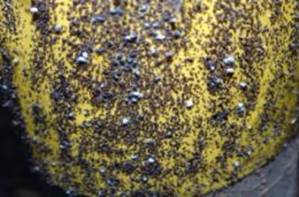
Woolly apple aphid trapped in sticky bands

Count of WAA per one square cm
Initial infection of rust in pistachionut has been recorded in the month of May-June and the severity attained maximum (76.8%) in the month of September 2016. However, powdery mildew (Podosphaera leuchotricha) infection was initially observed in May month which attained peak in the month of June. Two new diseases viz., hazelnut anthracnose (Piggotia coryli) and blight (Alternaria sp) as well as die back (Dothiorella sp.) have been reported to affect its successful cultivation for the first time in India.
Efficacy of different fungicides have been evaluated during 2015-16 for their bioefficacy and Phytotoxicity against apple scab, powdery mildew, premature leaf fall, core rot, root rot and collar rot, Alternaria leaf spot and fly speck etc. detail of which is as mentioned below:
Bioefficacy and Phytotoxicity studies of different fungicides on apple diseases were conducted during 2015-2016 crop seasons and some are listed below: Bioefficacy and phytotoxicity study of Custodia (Azoxystrobin 11%+ Tebuconazole 18.3 % SC) against Scab of apple
Data on comparative efficacy of test fungicide custodia revealed custodia (2ml/lt) was most effective and resulted in 3.30 per cent apple scab severity as compared to 76.81 per cent severity in control followed by custodia (1.5ml/l) whereas custodia (1ml/l) was next best in order while Sulphur (4g/l) was least effective. Similarly fruit yield was highest in custodia treatment.
1. Bioefficacy and phytotoxicity study of Custodia against premature leaf fall in apple
The perusal of data revealed that Custodia (2ml/l) resulted in minimum disease severity of 2.59 per cent followed by custodia (1.5ml/l) which were significantly superior (1.69%) from other treatments and statistically at par with each other. These were followed by Azoxystrobin (7.83%) and custodia @ 1.5 ml/l respectively.
A. Bioefficacy and phytotoxicity study of Custodia against PM
Custodia was quite effective in controlling apple powdery mildew as comparison to unsprayed treatment. Custodia (0.5%) resulted in minimum disease severity of 3.12 per cent followed by Custodia (0.3%) which was significantly superior from other treatments and statistically at par with each other. These were followed by tebuconazole (0.05%) and custodia (0.25%) with a disease severity of 5.53 and 6.32 per cent severity respectively. However, custodia (0.2%) were also effective in reducing powdery mildew severity in apple with severity of 10.28 per cent
B. Bioefficacy and Phytotoxicity report of MACT-01 (Tebuconazole 8% +Captan 32% SC) against Scab of apple
MACT-01 (5ml/l) resulted in minimum disease severity of 3.09 per cent followed by MACT-01 (3ml/l) which was significantly superior from other treatments and statistically at par with each other. These were followed by MACT-01 (2.5ml/l) and MACT-01 (2ml/l) with a disease severity of 5.51 and 6.72 per cent respectively, whereas Tebuconazole 25.9%EC (1.5ml/l) was next best in order.
C. Efficacy of Proquinazid 20 EC and other fungicides against powdery mildew of apple under filed conditions.
Proquinazid was found quite effective in controlling apple powdery mildew in comparison to unsprayed treatment. Proquinazid (8ml/10l) resulted in minimum disease severity of 2.72 per cent followed by Proquinazid (4.0ml/10l) which was significantly superior from other treatments and statistically at par with each other. These were followed by Proquinazid (2.5 and 2.0ml/10l respectively) with a disease severity of 8.78 and 12.42 per cent severity respectively.
D. Custodia and other fungicides against powdery mildew of apple
Custodia (0.5%) resulted in minimum disease severity of 3.12 per cent followed by Custodia (0.3%) which was significantly superior from other treatments and statistically at par with each other. These were followed by tebuconazole (0.05%) and custodia (0.25%) with a disease severity of 5.53 and 6.32 per cent severity respectively. However, custodia (0.2%) were also effective in reducing powdery mildew severity in apple with severity of 10.28 per cent.
E. Ergon against Alternaria blight in apple
Ergon (2ml/l) resulted in minimum disease severity of 3.02 per cent followed by Ergon (1.0 ml/l) with disease severity of5.27 per cent respectively, which was significantly superior from other treatments and statistically at par with each other. These were followed by Ergon (0.5%) and ergon (0.4%) while, Hexaconazole (0.05%) which were also effective in reducing disease severity of 10.28 per cent. Maximum fruit yield (65.29 kg) was recorded in ergon (2ml/l) which was statistically superior to other treatments
F. Bioefficacy of Maccani against apple scab
The perusal of the data revealed that Maccani (1g/L) was quite effective in controlling apple scab (4.96%) (Table-13) in comparison to unsprayed treatment followed by Maccani (0.8 & 0.6 g/l) which resulted only 6.22 and 7.40 per cent disease severity than control (43.68%). However, propineb (0.3 g/l) was next best in order exhibiting 8.55 per cent disease severity.
G. Bioefficacy of Lustre against premature leaf fall
The perusal of the data revealed that Lustre (0.03%) was quite effective in controlling premature leaf fall (11.72%) (Table-14) in comparison to unsprayed treatment followed by Lustre (0.022& 0.015 %l) which resulted only 13.29 and 14.69 per cent disease severity than control (72.42%). However, Carbendazim (0.0125%) was next best in order exhibiting 14.74 per cent disease severity. Maximum fruit yield was also recorded in Lustre (0.03%) which was statistically superior to other treatments followed by Lustre (0.022%).
H. Bioefficacy of Lustre against Alternaria leaf spot
The perusal of the data revealed that Lustre (0.03%) was quite effective in controlling Alternaria leaf spot (7.98%) (Table-15) in comparison to unsprayed treatment followed by Lustre (0.022& 0.015 %) which resulted only 8.70 and 13.47 per cent disease severity than control (49.64%). However, flusilazole and hexaconazole were next best in order exhibiting 8.77 &8.81 per cent disease severity. Maximum fruit yield (48.39 kg) was recorded in Lustre (0.03%) which was statistically superior to other treatments followed by Lustre (0.022%) with fruit yield of 34.37 kg.
I. Bioefficacay of Taqat against premature leaf fall in apple
The perusal of the data revealed that Taqat (1.0.%) was quite effective in controlling premature leaf fall in apple (7.51%) in comparison to unsprayed treatment followed by Taqat (0.75% and 0.5%) with 9.33 and 13.55 per cent severity. Mancozeb (0.3%) provided next best control with 13.92 per cent severity. Maximum fruit yield (52.01 kg) was recorded in Taqat (1.0%) which was statistically superior to other treatments followed by Taqat (0.75%) with fruit yield of 38.40 kg.
J. Bioefficacy of Taqat against Alternaria leaf spot in apple
The perusal of the data revealed that Taqat (1.0.%) was quite effective in controlling Alternaria leaf spot in apple (6.12%) (Table-17) in comparison to unsprayed treatment followed by Taqat (0.75% and 0.5%) with 9.28 and 13.37 per cent severity. Hexaconazole (0.5%) provided next best control with 13.58 per cent severity. Maximum fruit yield (51.55 kg) was recorded in Taqat (1.0%) which was statistically superior to other treatments followed by Taqat (0.75%) with fruit yield of 43.33 kg.
3. Transfer of Technology (TOT):
Under the project, expenditure of Rupees 30,000/- has been interpolated to digging of pits, filling of pits and plantation of highly improved cultivar of apple cv. Super Chief on clonal rootstock MM-111 at two different locations viz. village Kalpa in Development Block kalpa and research farm of Regional Horticultural Research and training Station & Krishi Vigyan Kendra Sharbo Kinnaur to establish the model demonstration orchards of high density plantation. High density orchards of 100 plants established at 3.5X3 meter of spacing each at Research farm of RHR&TS Sharbo and village Kalpa.
Hi-tech improved agricultural implements to carry out regular cultural/intercultural operations were procured i.e. Power tiller 1 No, Honda rotary tiller 2No, Brush cutter 1 No, Pruning Saw Felco 600 10 No’s, Pruning secateurs 10 No’s, Grafting and Budding Knifes 10 No’s and Power Sprayer 2 No’s.
Installation of Drip irrigation system for demonstration, success and sustainability of high density orcharding at two different location for 100 plants (3.5X3 meter) at Regional Horticultural Research and Training Station Sharbo, Kinnaur research farm and village Kalpa (community land) for the demonstration of efficient use of water with maximum saving of this important resource. Tree white wash, insecticides and Tree spray oil purchased for the high density plantation for protection against insect pests and diseases.
Procured 200 Super Chief cv. of apple grafted on MM-111 from Grewa Nursery through Director of Research, Nauni and established orchards of 100 plants each at two different locations to demonstrate High Density Orcharding to the tribal orchardists/ farmers of district Kinnaur. Expenditure amounting Rs.2,000,00 lacks to conduct training and awareness programme on high density plantation and exposure visit of high density planting site and to select interested tribal farmers for exposure visit to Leh-ladhakh. Expenditure amounting Rs. 4,000,00 to conduct exposure visit of 35 No’s of tribal farmers of district Kinnaur to Leh-Ladakh region. Purchase of vermicompost, single super phosphate, murate of potash, calcium nitrate and fungicides/pesticides for high density apple plantation has been carried out of amounting Rs. 1,40,000.
Introduction of high density plantation at this location will enhance production and productivity of apple fruit crops in tribal district of Kinnaur. This will uplift the livelihood and increase the food and nutritional security. This will motivate the tribal farmers to adopt the high density orcharding of new improved varieties of apple in the changing climatic scenario. The high density plantation of Super Chief on clonal rootstock MM-111 will reduce the gestation period and induce early fruiting which shortens the gestation period of apple fruit crop. Intercultural practices will be carried out with mechanical means such as Power tiller, power weeder and grass cutter etc.